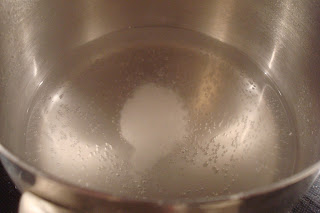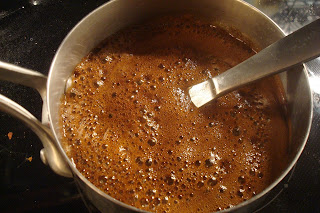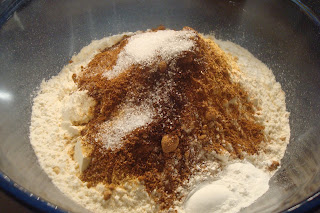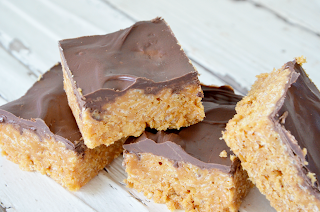Say what? A non-This-Week-in-Geekdom post? I'm getting to the point in this not-semester's worth of studying where burnout is beginning to loom large. The brain takes in a tableau of equations for the umpteenth time, turns in on itself and meekly requests, "Could we please just not right now?"
It's been...ehm...a few years since undergrad, but I've found that I revert readily to what had once been tried-and-true study break behavior. This primarily takes the form of baking; it's edible chemistry! It's also a great way to address any and all cravings. In my case, it was the desire for the deep, spice-laden flavor of gingerbread even though the holidays have come and gone. The following recipes both began at one of my favorite online purveyors of make-your-own deliciousness, SmittenKitchen.com, and got a few tweaks partially borne from chemistry and partially due to the availability of ingredients I had on hand.
Both recipes are a little involved, but yield some seriously bold, fluffy, cakey gingerbread. Bonus: your kitchen will be redolent with awesome for several hours post-baking.

Difficulty: Medium
It's been...ehm...a few years since undergrad, but I've found that I revert readily to what had once been tried-and-true study break behavior. This primarily takes the form of baking; it's edible chemistry! It's also a great way to address any and all cravings. In my case, it was the desire for the deep, spice-laden flavor of gingerbread even though the holidays have come and gone. The following recipes both began at one of my favorite online purveyors of make-your-own deliciousness, SmittenKitchen.com, and got a few tweaks partially borne from chemistry and partially due to the availability of ingredients I had on hand.
Both recipes are a little involved, but yield some seriously bold, fluffy, cakey gingerbread. Bonus: your kitchen will be redolent with awesome for several hours post-baking.
Difficulty: Medium
Availability of Ingredients: Common
Gadgetry: None
Feeds: 6-10 nerds
Time Till Noms: 60-75 minutes, but at least 30-35 of those minutes are passive while the gingerbread bakes.
Required Equipment: A saucepot, a large glass or other heatproof bowl, a heatproof mixing spoon, measuring cups, measuring spoons, a large glass or metal baking pan.
Optional Equipment: A spice grater, a sifter
Ingredients
1 cup of water
1.5 teaspoons of baking soda
8 Tablespoons of unsalted butter, plus a few more if you're using them to grease your pans.
2/3 cup of brown sugar
1 cup unsulfured molasses (not blackstrap)
2.5 cups flour, plus a little more if you're using it to flour your pans
2 large eggs brought to room temperature
2 teaspoons ground ginger
1.5 teaspoons ground cinnamon
0.5 teaspoons ground cloves
0.5 teaspoons ground nutmeg
0.5 teaspoons of salt
2 teaspoons baking powder
A small quantity of confectioner's sugar for dusting over the finished bread
Parchment paper or cooking spray
1 Tablespoon of freshly ground ginger (optional)
1 Tablespoon of freshly ground ginger (optional)
*heat your oven to 350 degrees (176.67 Celsius)
Step 1) Line your baking dish with parchment paper, then butter and flour the dish. Alternatively, you can coat it liberally with your cooking spray. If you're using spray, you may want to give the measuring cup that will be holding the molasses a spritz, as this will help release all of the sticky goodness later. Cut the remaining butter into small chunks and, if you haven't already, bring your eggs out so they can come up to room temperature.
Step 2) In your saucepot, bring the water to a rapid boil, then add your baking soda. This will produce a fun fizzy/foamy reaction for a few seconds. Woo, chemistry! Remove the water/soda mixture from the heat source and leave it to stand for five minutes.

Step 3) Once your soda-water has settled, add your butter into the mix and swirl everything together until the butter has completely melted. From here, add the brown sugar and molasses and stir until you have a nice, homogeneous mixture. If you're using fresh ginger, now would be the time to grate that over your saucepan and incorporate that into the mixture.



Step 4) Add the following to your heatproof bowl: the flour, baking powder, salt, cinnamon, cloves, ground ginger, and nutmeg. If you have a sifter and want to get fancy, you can sift these together or, if you're really into not doing dishes and your saucepan is large enough, you can sift these directly into the saucepan. If your saucepan isn't quite big enough, pour the contents of it onto the dry ingredients in your heatproof bowl and stir until until everything is uniform.

Step 5) If the resulting mixture feels hot to the touch, let it cool for 10-15 minutes. If it doesn't, add your eggs and give everything one last good stir to ensure homogeneity.
Step 6: Pour your batter into your baking dish, then bake for 30-35 minutes. Once the gingerbread has finished its sojourn into the oven, let it cool completely. If you'd like, you can sprinkle some confectioner's sugar over the top once the gingerbread is cool to the touch. Yay!

Step 2) In your saucepot, bring the water to a rapid boil, then add your baking soda. This will produce a fun fizzy/foamy reaction for a few seconds. Woo, chemistry! Remove the water/soda mixture from the heat source and leave it to stand for five minutes.
Step 3) Once your soda-water has settled, add your butter into the mix and swirl everything together until the butter has completely melted. From here, add the brown sugar and molasses and stir until you have a nice, homogeneous mixture. If you're using fresh ginger, now would be the time to grate that over your saucepan and incorporate that into the mixture.
Step 4) Add the following to your heatproof bowl: the flour, baking powder, salt, cinnamon, cloves, ground ginger, and nutmeg. If you have a sifter and want to get fancy, you can sift these together or, if you're really into not doing dishes and your saucepan is large enough, you can sift these directly into the saucepan. If your saucepan isn't quite big enough, pour the contents of it onto the dry ingredients in your heatproof bowl and stir until until everything is uniform.
Step 5) If the resulting mixture feels hot to the touch, let it cool for 10-15 minutes. If it doesn't, add your eggs and give everything one last good stir to ensure homogeneity.
Step 6: Pour your batter into your baking dish, then bake for 30-35 minutes. Once the gingerbread has finished its sojourn into the oven, let it cool completely. If you'd like, you can sprinkle some confectioner's sugar over the top once the gingerbread is cool to the touch. Yay!
Difficulty: Hard
Availability of Ingredients: Somewhat Common
Gadgetry: None
Feeds: 6-10 nerds
Time Till Noms: 70-85 minutes, but up to 50 of these minutes are passive as the gingerbread bakes.
Required Equipment: A saucepot, a large glass or other heatproof bowl, another mixing bowl, a heatproof mixing spoon, a whisk, measuring cups, measuring spoons, a glass or metal baking dish.
Optional Equipment: A bundt pan, a spice grater, a sifter
Ingredients
1 cup of Irish dry stout or oatmeal stout (I used Guinness stout and it worked very well)
0.5 teaspoons of baking soda
1 cup brown sugar
1 cup granulated sugar
1 cup of unsulfured molasses (not blackstrap)
2 cups flour
1.5 teaspoons of baking powder
2 Tablespoons of ground ginger
1 teaspoon of ground cinnamon
0.25 teaspoon ground cloves
0.25 teaspoon ground or freshly grated nutmeg
a pinch of ground cardamom
3 large eggs, brought to room temperature
0.75 cups of vegetable, canola, or safflower oil
Parchment paper or cooking spray
A small amount of confectioner's sugar for dusting over the finished bread
Step 1) Line your baking dish with parchment paper, then butter and flour the dish. Alternatively, you can coat it liberally with your cooking spray. If you're using spray, you may want to give the measuring cup that will be holding the molasses a spritz, as this will help release all of the sticky goodness later. **Note: if you're trying to make this in a bundt pan, be especially liberal with the buttering/flouring. This batter ends up extremely sticky.**
Step 2) In your saucepan, combine your molasses and stout, then bring that mixture to a boil. Once it's boiling, add your baking soda, stir, and remove the whole shebang from your heat source.
Step 3) Add to your heatproof bowl the flour, baking powder, ginger, cinnamon, cloves, nutmeg, and cardamom. Stir these gently to combine.
Step 4) Add the three eggs and both types of sugar to your other mixing bowl. Whisk these together, then add your oil and whisk that into the mix as well.
Step 5) Give the molasses and stout mixture a quick feel test. If it's close to room temperature (or at least isn't hot), then add the contents to the bowl with the eggs/sugar mixture and stir everything together. Once you have a homogeneous blend, toss that in with the flour and spices. Stir the whole shebang together until everything is uniformly combined.
Step 6) Pour the resulting batter into your pan and give the pan a few sharp raps on your countertop to eliminate any air bubbles that may have formed. Place the pan in the oven and bake for 30-40 minutes if you're using a rectangular baking dish and 50 minutes if you're using a bundt pan.
Step 7) Once the gingerbread has finished its sojourn into the oven, let it cool completely. Sprinkle some confectioner's sugar over the top once the gingerbread is cool to the touch. Yay!
FAQs
Does it matter what type of brown sugar I use?
Not really. Dark brown sugar tends to jive a little better with the ingredients in these recipes, but there's no real reason why you couldn't use light brown sugar. Just ensure that it's brown sugar you're using and not, say, cane or some other form of raw sugar.
Why shouldn't I use blackstrap molasses?
Honestly you could, but your gingerbread would turn out with an extremely intense, somewhat bitter flavor that would likely be overwhelming for most palettes. If you like your gingerbread to be incredibly bold and on the less sweet side, then go right ahead and use blackstrap.
What's with the boiling of liquids? Can I just skip that step and add those ingredients directly to the others?
This step is what gives the gingerbread its fluffy, cakey texture. If you skip it the results will be quite different than if you hadn't.
Best of luck on your kitchen experimentations!







